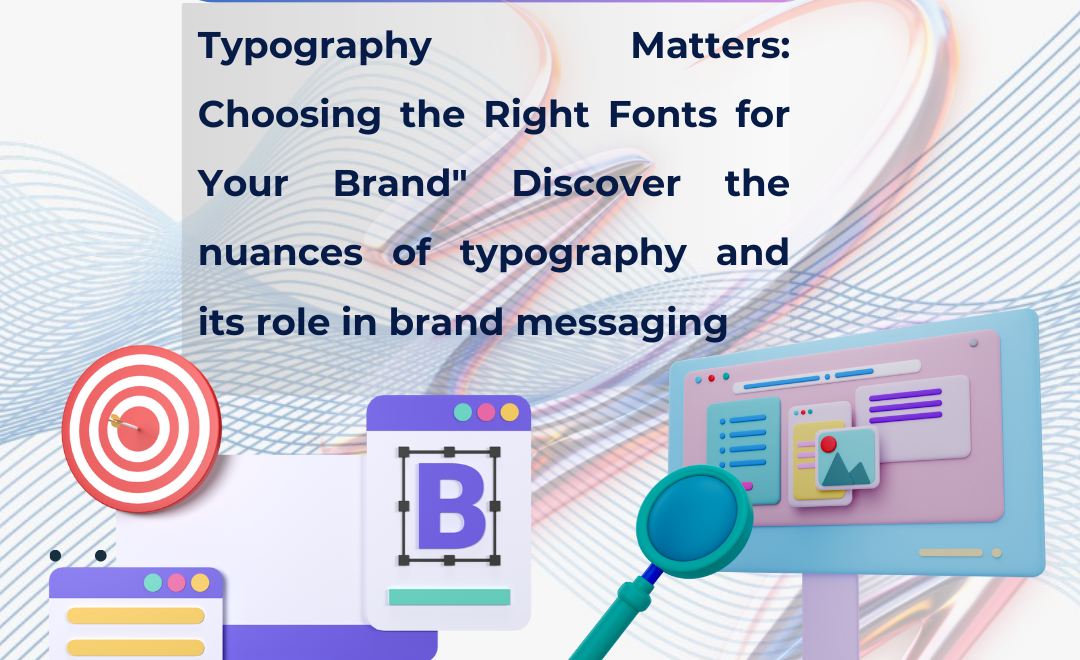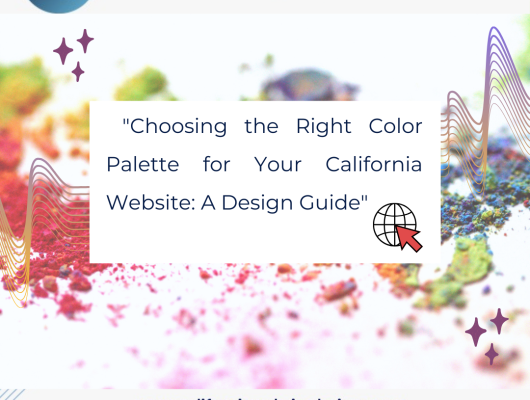Fonts and Typography: In the rapidly evolving digital landscape, characterized by brief attention spans and the paramount importance of initial impressions, typography emerges as a subtle yet powerful ambassador representing your brand. Beyond being mere letters on a screen, the fonts you select go beyond language; they encapsulate the very core of your brand’s identity. These fountains wield a profound influence on how your audience not only reads but also interprets and interacts with your content, shaping their perception and engagement in ways that resonate with the essence of your brand.
The Psychology of Fonts
Establishing Brand Personality
Fonts transcend the realm of mere letters; they are powerful conveyors of emotion and personality. Imagine your brand as a person—what mood does it exude? Modern, classic, playful, or formal? Each typeface carries its personality, and understanding the psychology behind the fountain allows brands to consciously align their typographic choices with the emotional response they wish to evoke.
For instance, sans-serif fonts, characterized by clean lines and the absence of decorative strokes, often evoke a sense of modernity and simplicity. Think of them as the sleek, minimalist friend in your group who always keeps things straightforward. On the other hand, script fonts, with their elegant and flowing characters, inject a touch of sophistication and charm. They’re like the friend who effortlessly adds a touch of grace to every occasion.
Consider a state of affairs in which you are designing a logo for a tech startup that prides itself on innovation and ease. Opting for a sans-serif font could not best carry a cutting-edge and streamlined picture; however, it additionally resonates with the brand’s dedication to cutting-edge solutions. Understanding the psychology behind fonts empowers you to make intentional choices that align seamlessly with your brand’s personality.
Building Trust and Credibility
In the digital landscape, where trust is the cornerstone of successful interactions, the right fonts play a pivotal role in instilling confidence in your audience. Serif fonts, characterized by the small decorative lines or strokes at the ends of characters, carry a timeless and traditional appeal. They are akin to the friend who exudes reliability and steadfastness.
Picture a financial institution aiming to convey a sense of trustworthiness and stability. Choosing a serif font for their communications and branding would not only echo tradition but also subconsciously communicate reliability to their audience. It’s about creating a visual language that aligns with the values your brand holds dear.
Moreover, selecting a font that resonates with your brand’s values goes beyond aesthetics; it establishes a connection with users on a deeper level. If you’re brand values tradition, reliability, and a sense of history, opting for a serif font becomes a strategic choice. It’s the silent communicator that reinforces your commitment to trust and credibility in the digital space.
In essence, the psychology of fonts is a powerful tool in your branding arsenal. It’s about understanding the unspoken language of typefaces and leveraging it to create a resonant and trustworthy brand image. Whether you’re aiming for modernity or tradition, playfulness or formality, the fonts you choose become the voice of your brand, speaking directly to the hearts and minds of your audience.
Practical Considerations in Typography
Readability and Accessibility: Ensuring Inclusivity for All
In the dynamic landscape of digital content consumption, where diverse devices and screen sizes abound, prioritizing readability and accessibility is paramount. Imagine your website’s content as a message and the chosen font as the vessel carrying that message. It’s not just about how beautiful the vessel looks; it’s about ensuring that the message reaches everyone, regardless of their device or abilities.
Readability across Devices
The beauty of your chosen font should not come at the expense of legibility. Fonts that are clean to study on a laptop can also grow to be challenging on a smaller mobile display. Striking stability between aesthetic enchantment and legibility ensures that your target audience can results easily interact with your content material, irrespective of the device they may be using.
Embracing Accessibility Standards
Accessibility goes beyond mere readability—it’s about inclusivity. Consideration of color contrast and font size is pivotal. A high color contrast ensures that text is discernible against the background, catering to users with visual impairments. Similarly, opting for an adequate font size enhances readability, benefiting users of all abilities.
Imagine a website that uses a sleek script font for its headings. While visually appealing, this fountain may pose challenges for users with visual impairments or those accessing the site on smaller screens. By choosing a font with high contrast and adjusting the size appropriately, the website becomes more inclusive, welcoming a broader audience.
Consistency across Platforms: Building Trust through Uniformity
In the vast digital ecosystem, your brand interacts with users on various platforms—your website, social media channels, and even traditional printed materials. Consistency in typography across these touchpoints is more than a visual choice; it’s a strategic move to build a cohesive brand identity that resonates with your audience.
Unified Font Strategy
Imagine your brand as a story and each platform as a chapter in that narrative. A unified font strategy ensures that each chapter maintains the same tone, creating a seamless reading experience for your audience. Whether they encounter your brand on Instagram, your website, or a printed brochure, consistent typography reinforces brand recognition.
The Power of Familiarity
Consistency breeds familiarity, and familiarity breeds trust. When your audience encounters the same fountain across different platforms, it establishes a sense of reliability. They subconsciously associate those fonts with your brand, creating a mental link that strengthens over time. This trust is a valuable asset in a digital landscape where credibility is a currency.
Consider a brand that uses a bold sans-serif font for its website headers. If the same font is echoed in social media posts and marketing materials, users instantly recognize the brand, even without seeing the logo. This uniformity builds trust, as users feel confident in their association with a consistent and reliable brand.

Fonts in Web Design
Responsive Typography: Ensuring Impact across Devices
In the contemporary digital panorama, in which users get access to online content through a myriad of gadgets, responsive typography has become a non-negotiable element of effective net layout. The crux of responsive typography lies in its capacity to conform to unique display sizes and resolutions, ensuring that your message retains its impact irrespective of the tool.
Consider a website catering to both laptop users and cellular traffic. Without responsive typography, the text can also seem disproportionately massive on a telephone or uncomfortably small on a laptop display. By imposing responsive typography, the font length dynamically adjusts to maintain top-rated readability, providing an unbroken and visually appealing experience across numerous gadgets.
Loading Speed Optimization: Enhancing User Satisfaction and SEO
Font files wield considerable influence over a website’s loading times, directly affecting user satisfaction and search engine rankings. In the pursuit of a well-rounded web experience, optimizing loading speed becomes paramount. It involves a strategic approach to font selection and loading techniques, striking a harmonious balance between aesthetic preferences and performance.
Imagine a scenario where a website with intricate and high-resolution fountains takes an extended time to load, leading to a frustrating user experience. On the flip side, a website employing a web-safe fountain and modern loading techniques ensures swift loading, keeping users engaged and satisfied. It not only fosters a positive perception of the brand but also contributes to improved search engine rankings, as loading speed is a significant factor in search algorithms.
Web-Safe Fonts: Balancing Aesthetics and Performance
Web-safe fonts play a pivotal role in the loading speed optimization of a website. These fountains are widely supported across various devices and browsers, eliminating the need for extensive font file downloads. Opting for web-safe fonts ensures a faster loading time, contributing to a seamless user experience.
Consider an internet site that uses a common net-safe font like Arial or Times New Roman. These fountains are pre-mounted on most devices, decreasing the need for extra downloads. As a result, the internet site hundreds swiftly, providing users with quick access to content material. It now not only complements person satisfaction but also definitely influences search engine rankings, as loading velocity is an essential issue in figuring out internet site relevance.
Modern Font Loading Techniques: Striking the Perfect Balance
In the quest for an aesthetically pleasing website, modern font-loading techniques come into play. The “font-display” property, for instance, allows developers to control how fonts render during the page load. It empowers designers to prioritize either speed or aesthetics, finding the optimal balance for user experience and search engine optimization.
Imagine a website utilizing the font-display property to prioritize the display of content over the immediate loading of custom fountains. As a user navigates through the site, the text appears in a default, easily readable font while the custom font loads in the background. This approach provides a seamless user experience, combining aesthetic appeal with efficient loading times.
The consideration of responsive typography, loading speed optimization through web-safe fonts, and the implementation of modern font loading techniques are crucial aspects of effective web design. By understanding and implementing these strategies, brands can ensure that their online presence is not only visually appealing but also optimized for user satisfaction and search engine performance.
Making the Right Font Choices
Conducting a Brand Audit
Before you embark on the journey of selecting fountains for your brand, it’s imperative to conduct a thorough brand audit. This process involves introspection and analysis to align your typographic choices with the essence of your brand.
Understanding Your Brand’s Values
Start by identifying the core values that define your brand. Are you aiming for innovation, tradition, playfulness, or professionalism? For example, a tech startup may lean towards modern and sleek fonts to convey innovation, while a heritage brand might opt for classic and timeless fonts to reflect tradition.
Knowing Your Target Audience
Your audience plays a pivotal role in shaping font decisions. Consider the demographics, preferences, and expectations of your target audience. If your brand caters to a youthful demographic, you might explore a bold and vibrant fountain. Conversely, a more mature audience might appreciate refined and sophisticated typefaces.
Defining Overall Aesthetic
The overall aesthetic of your brand sets the tone for font selection. Whether it’s minimalistic, extravagant, vintage, or contemporary, your chosen fonts should seamlessly integrate with this aesthetic. For instance, a luxury brand embracing a minimalist aesthetic might opt for clean and elegant serif fonts.
Creating a Visual Brand Style Guide
To maintain consistency in your brand’s visual identity, consider creating a visual brand style guide. This guide should encompass your preferred typography styles, including font families, sizes, and spacing. It becomes a reference point for anyone creating content for your brand, ensuring a cohesive and unified presentation.
Embracing Customization
While the digital realm offers an abundance of pre-designed fonts, the true essence of brand individuality often lies in custom typography.
Distinguishing from Competitors
Custom fonts allow you to stand out in a crowded market. Consider the competition in your industry; if everyone is using a similar fountain, a custom typeface can be a game-changer. For instance, if you’re in the food industry, a bespoke handwritten font can add a personal touch, distinguishing your brand from others.
Reflecting Brand Personality
Your brand has a unique personality, and custom typography provides a direct channel to express it. Think about the traits you want to convey—whether it’s friendliness, professionalism, or quirkiness—and tailor your font accordingly. A daycare center might opt for playful and rounded fonts, creating a warm and inviting vibe.
Establishing a Memorable Brand Signature
Custom typography goes beyond a mere design choice; it becomes a signature element of your brand. When customers see your distinct font, they should immediately associate it with your brand. This memorability fosters brand recall and strengthens the connection between your audience and your products or services.
Making the right font choices involves a meticulous brand audit and, in some cases, the bold step of embracing customization. By understanding your brand’s values, knowing your target audience, defining the overall aesthetic, and even creating a visual brand style guide, you lay the groundwork for informed font selection. Embracing customization allows your brand to not only distinguish itself from competitors but also to craft a unique and memorable identity through bespoke typography.
Conclusion:
In the dynamic realm of the internet, where every pixel fights for a moment of attention, the impact of typography cannot be overstated. It serves as the unsung hero that molds how your brand is perceived in the minds of your audience. Imagine it as the voice of your brand in a crowded room, conveying emotions and building connections without uttering a word. Whether you’re tugging at heartstrings with a whimsical script or exuding professionalism with a classic serif, the fonts you choose wield the power to resonate with your audience on a visceral level.
At California Website Designer Agency, we recognize the pivotal role typography plays in crafting a compelling digital narrative. Our commitment goes beyond aesthetics; it’s about forging a visual language that speaks directly to your audience. In the cacophony of online content, we understand that your brand needs more than visibility; it demands a memorable presence. Our meticulous approach involves a deep dive into your brand identity, ensuring that every font choice aligns seamlessly with your values and goals.
In this fast-paced digital landscape, where attention is a scarce commodity, California Website Designer Agency stands as your ally in making a lasting impression. We don’t just design websites; we curate digital experiences that leave an indelible mark. By harnessing the art and science of typography, we empower your brand to be not only seen but also remembered. In the world of pixels and bytes, let your typography be the ambassador that captivates, resonates, and ultimately elevates your brand to new heights.

Frequently Asked Questions
Q1: Why does typography matter for my brand’s success?
A: Typography is the visible language of your brand. The proper fonts evoke feelings, set up, consider, and make a contribution to effective communication; gambling plays a crucial function in shaping how your target audience perceives and engages with your emblem.
Q2: How do I choose the proper fonts for my brand?
A: Start by knowing your emblem’s persona and values. Consider the temper you need to convey and the feelings you need to evoke. Conduct an emblem audit and select fonts that align with your identification and resonate with your target market.
Q3: Are there specific fonts associated with trust and credibility?
A: Yes, serif fonts are often associated with tradition and reliability. Their classic appeal can instill confidence and credibility in your audience. However, the right choice depends on your brand’s specific characteristics and goals.
Q4: Does typography impact website performance?
A: Yes, it does. Font files can affect loading times. Opt for a web-safe fountain and employ loading optimization techniques, like font-display, to balance aesthetics and performance, ensuring a seamless user experience.
Q5: How does responsive typography work, and why is it important?
A: Responsive typography adjusts font size to different devices, ensuring optimal readability. It’s crucial in the digital age, where users access content on various screens. Implementing it enhances the user experience and contributes to better search engine optimization.
Q6: Can I use custom fonts for my brand, and how do they enhance brand identity?
A: Absolutely. Custom fonts add a unique touch to your brand, setting it apart from competitors. Tailoring a font to your brand’s personality creates a memorable and distinctive brand signature.
Q7: Is there a universal rule for font consistency across platforms?
A: Yes, maintaining a consistent typographic identity across all brand touchpoints is essential for reinforcing brand recognition. Create a visual style guide that encapsulates your font preferences to ensure a cohesive brand image.
Q8: How do I balance aesthetics and readability in my font choices?
A: Prioritize readability without compromising aesthetics. Choose fonts that are legible across devices and screen sizes. Consider factors like color contrast and font size to enhance accessibility and widen your audience reach.
Q9: Are there trends in typography, and should I follow them?
A: While trends can offer inspiration, it’s crucial to balance them with your brand’s identity. Focus on timeless elements that align with your brand, ensuring your typography remains relevant in the long run.
Q10: Can typography enhance my brand’s storytelling?
A: Absolutely. Fonts convey more than words; they carry emotion and personality. Choosing fonts that align with your brand’s narrative enhances storytelling, creating a more immersive and memorable experience for your audience.






